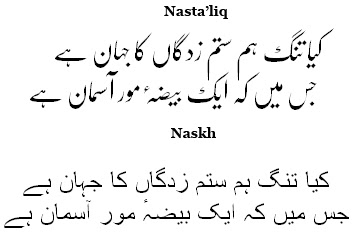PakAlumni Worldwide: The Global Social Network
The Global Social Network
Apple iOS 11 Supports Nastaliq as Default Font for Urdu
Apple today announced iPhone 8, iPhone 8 Plus and a $1000 iPhone X today, the 10th anniversary of the first iPhone launch, at its new Spaceship-shaped headquarter in Silicon Valley. iOS 11operating system is also being launched along with the new hardware to support many advanced new features for face identification, wireless charging and augmented reality (AR). In addition, the OS 11 will include nastaleeq font that is popular with Urdu publishers in Pakistan, according to Silicon Valley based Urdu lover and Nastaliq campaigner Mudassir Azeemi.
History of Nastaliq on Apple:
Apple did include nastaliq font in iOS 9 Beta 1 after a persistent campaign by Mudassir Azeemi. Unfortunately, it was later dropped in the released version of iOS X. But Mudassir continued his efforts which appear to have born fruit with iOS 11 being released this month. Apple will now drop naskh and support only nastaliq in native mode for rendering Arabic, Persian and Urdu languages.
Naskh vs Nastaliq:
Apple today supports naskh font which are used for Arabic, Persian and Urdu. Most Urdu lovers, however, prefer the beauty of nastaliq font. Here's how South Asian writer Ali Eteraz describes the two fonts:
"Looking at the (rendering of the two fonts), the discerning eye may immediately realize why naskh trumps nastaliq on digital devices. With its straightness and angularity, naskh is simply easier to code, because unlike nastaliq, it doesn’t move vertically and doesn’t have dots adhering to a strict pattern. And we all know how techies opt for functionality. Utility being the mother of expansion, naskh is quickly phasing out nastaliq on the web. BBC-Urdu and Urdu Voice of America both use naskh; so does Alarabiya Urdu. And if you want to write an SMS in nastaliq, you must use naskh as well. Same holds true for social media: Facebook, naskh; Twitter, naskh; blogs, naskh."
Use of Image Files:
Nastaliq lovers like Pakistan's Jang Media Group and others have not given up on their preferred script. Instead of using naskh, they have resorted to using uploaded image files for publishing content on their websites.
Other Platforms:
Unfortunately, none of the other operating systems support nastaliq in native mode yet. They all support naskh which is becoming the dominant font for Urdu along with Arabic and Persian. However, Mudassir Azeemi believes that Apple's decision to only support nastaliq in native mode will influence all operating system vendors and social media apps like twitter and Facebook to start using nastaliq as default for Urdu.
Summary:
Apple's decision to drop naskh and include nastaliq as the default font for Urdu, Arabic and Persian is likely to have a major impact on all operating systems and social media platforms. It's welcome news for Urdu lovers like Ali Eteraz and Mudassir Azeemi who have been deeply unhappy with what they describe as "the death of the Urdu script".
Related Links:
Pakistani-American Foundation Releases Khan Academy's Videos in Urdu
Cemendtaur's Book Launch at Urdu Academy in Silicon Valley
US Mining Urdu Content on Facebook, Twitter
Twitter Feed
Live Traffic Feed
Sponsored Links
South Asia Investor Review
Investor Information Blog
Haq's Musings
Riaz Haq's Current Affairs Blog
Please Bookmark This Page!
Blog Posts
IMF Questions Modi's GDP Data: Is India's Economy Half the Size of the Official Claim?
The Indian government reported faster-than-expected GDP growth of 8.2% for the September quarter. It came as a surprise to many economists who were expecting a slowdown based on the recent high-frequency indicators such as consumer goods sales and durable goods production, as well as two-wheeler sales. At the same time, The International Monetary Fund expressed doubts about the Indian government's GDP data. …
ContinuePosted by Riaz Haq on November 30, 2025 at 11:30am — 2 Comments
Retail Investor Growth Driving Pakistan's Bull Market
Pakistan's benchmark index KSE-100 has soared nearly 40% so far in 2025, becoming Asia's best performing market, thanks largely to phenomenal growth of retail investors. About 36,000 new trading accounts in the South Asian country were opened in the September quarter, compared to 23,600 new registrations just three months ago, according to Topline Securities, a brokerage house in Pakistan. Broad and deep participation in capital markets is essential for economic growth and wealth…
ContinuePosted by Riaz Haq on November 24, 2025 at 2:05pm — 2 Comments
© 2025 Created by Riaz Haq.
Powered by
![]()

You need to be a member of PakAlumni Worldwide: The Global Social Network to add comments!
Join PakAlumni Worldwide: The Global Social Network